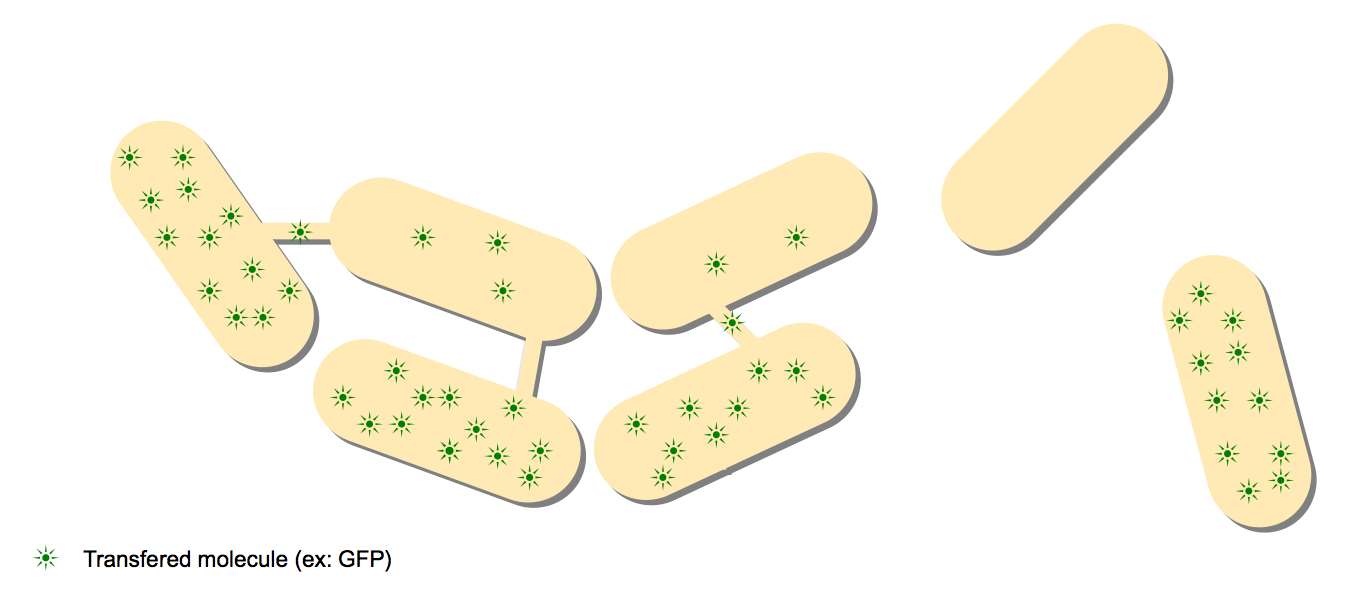Team:Paris Bettencourt/Designs
From 2011.igem.org
| Home | Team | Official Team Profile | Project | Designs | Parts Submitted to the Registry | Modeling | Notebook | Safety | Attributions |
|---|
Here is the design page, in wich is sum up all the potential designs we may do designs. This page is private for the moment, but it may become available on the open wiki soon.
Contents |
Designs for a direct observation
The principle of the Step 0 is basically to observe directly what pass from a prodicer cell to a receptor cell what pass through the nanotubes. There is no signal amplification is this step.
We currently have 2 designs for the step 0:
- The Antibiotics resistance experiences: The principle is to put two strains of bacteria that present a diifferent antibiotic resistance in presence in the same biofils. After a growth time together, they are putted in presence of the two antibiotics. They can resist together through a cooperative effect involving the exchange of enzymes of antibiotic resistance through the nanotubes
- The GFP-LacI fusion: The principle is to diffuse a GFP-LacI fusion protein from one cell that produce it to another cell that is without color, and contains a plasmid having several time repeted the LacO operon. The GFP will concentrate on the plasmid giving raise to a more intense fluorescence
Designs for nanotube characterization
The principle of the step 1 is to characterize the nanotube communication. The idea is to pass molecules of different sizes and monitor the increase of time between the apparition of the two monitors because of the nanotube diffusion time.
First you put the two construction in the same cell, and you induce with different quantities of IPTG. Then you measure the time between the apparition of the monitor 1 (RFP) and the monitor 2 (GFP). You reproduce a second time the experiment, but with the two construct inside two differents cells. The increase of the time is due to the diffusion time through the nanotubes.
We expect the time to increase with the size of the molecule as the diffusion coefficient is in D = K/R where K is a constant and R the Stoke radius.
We have two different familly of designs depending on the type of amplifier used for detecting the signal. There can be non reversible amplifiers (T7 self amplifier) and reversible amplifiers, in which the property of reversibility is not exploited (Toggle Switch). Here are the designs classified by amplifier types.
Non reversible amplifiers
- The T7 diffusion: The principle of this experiment is to pass T7 through the nanotubes, this T7 activating the T7 amplifier in the receptor cell.
- The tRNA amber suppressor diffusion: The tRNA amber suppressor diffusion: The principle of this design is to produce in one cell a tRNA amber supressor that will diffuse through the nanotubes. On the receptor cell, a T7 with amber stop codon is there to activate the T7 self amplifier, but cannot be transcribed as long as the tRNA amber suppressor is not there in the cell.
- The Xis protein diffusion: Xis is tha small partner of an exisase. This will exise a stop codon on the DNA strand that prevent the expression of the GFP.
Potentially reversible amplifiers
- The CI(ind) diffusion: The indestructible CI diffusion will change the toogle switch state
- The RecA* diffusion: The RecA diffusion will help the change of the toogle switch state
Two copoment system designs (for. B. Subtilis - E. Coli systems only)
- The MBP diffusion: We need a CRP+,MBP- E. Coli mutant. We produce the MBP protein in Bacillus subtilis and make it diffuse through the nanotube. As long as the MBP has not reach the E. Coli periplasm, the cell cannot digest the maltose that is in the medium. The indirect induction by the MBP of MalR trigger the expression of the reporter GFP
- The OmpR diffusion: We need a OmpR- Receptor* E. Coli mutant. We produce the OmpR protein in Bacillus Subtilis. As long as the OmpR has not diffused from the B. Subtilis, the signaling cascade cannot be active. With the rescue by Bacillus Subtilis of the OmpR protein, the expression of the reporter gene is activated.
Designs for a Master-Slave system
The principle of Step 2 is to build a Master-Slave system, where the Master slave control the state of the Slave cell in a monodirectional exchange.
Such a design imply to have all the sub-system reversible and the actuator and the amplifiers in particular, which makes the things non trivial.
There are several possibility of designs and they are summed-up below:
- The diffusive RecA push-on push-off system: In this design we re-use the 2010 Pekin iGEM team system of a push-on push-off system, but instead of triggering the change by UV, we trigger it making an always active RecA mutant through the nanotubes. We hope the emiter cell can control the change of the stage in the slave cell
- The transcient amplifier system: The system rely on a transcient amplifier that trigger a GFP pulse in the receptor cell
Designs for a bidirectional communication
If we succed in establishing a monodirectional communication, we may go on and try to build a bidirectional communication system. Here is the general scheme.
The genetic design combine the two previously described amplification system. The complete sumup is the following:
Hoping we can get there some day...
 "
"




